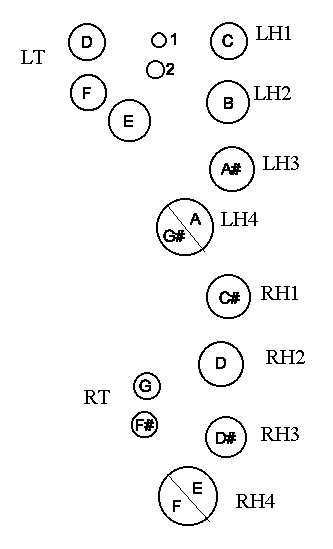 In this diagram, "1" and "2" are octave keys. Keys D, F, and E on the upper
left are played with the left thumb (LT), and keys G and F# are right thumb
(RT) keys. The other keys are labeled either "LH" (for left hand) or "RH"
(for right hand) with the finger number, e.g., "LH1" is the left index
finger. LH4 and RH4 each have two keys, with a roller between.
In this diagram, "1" and "2" are octave keys. Keys D, F, and E on the upper
left are played with the left thumb (LT), and keys G and F# are right thumb
(RT) keys. The other keys are labeled either "LH" (for left hand) or "RH"
(for right hand) with the finger number, e.g., "LH1" is the left index
finger. LH4 and RH4 each have two keys, with a roller between.
When playing, the LT thumb keys are used for the lowest D/E/F (low Eb is open - no key depressed). The remaining keys are used singly for the rest of the notes up to the F an octave higher. One presses only one key at a time: for example, going from D to C, one lifts the D key, and presses the C key. You do not hold the D key down while also pressing the C key. Thus, the fingering for a chromatic scale (F#-F) would be:
RT1(f#), RT2(g#), LH4(g#), LH4(a), LH3, LH2, LH1, RH1, RH2, RH3, RH4(e), RH4(f).
At that point, you've used all the keys except the octave keys. To reach the next octave, use "2" for notes G-C (RT1-LH1) and "1" for notes C#-F (RH1-RH4). For altissimo notes above that (if one can use the term "altissimo" with notes that barely reach middle C), use "1" for notes F#-middle C (RT2-LH1). Almost three octaves of range, in total.
At least, that's how it works on my horn. Yours may differ!
Copyright © 1997-98 by Grant D. Green